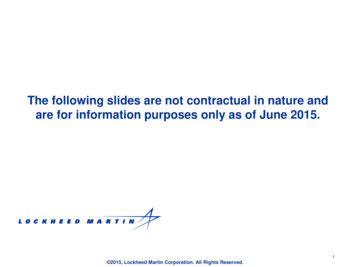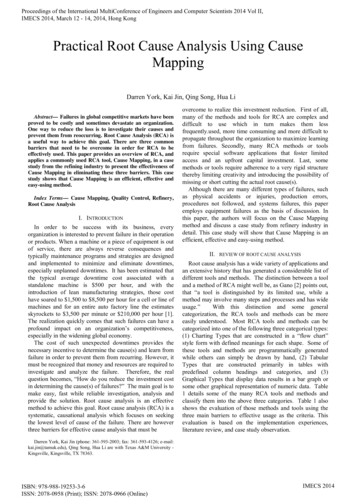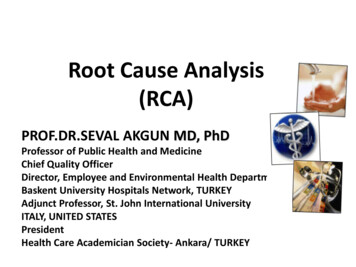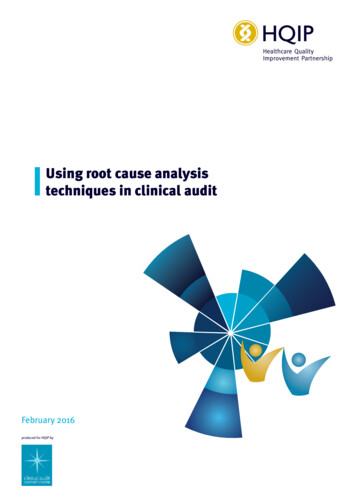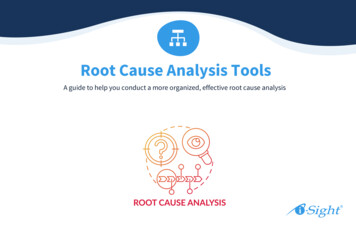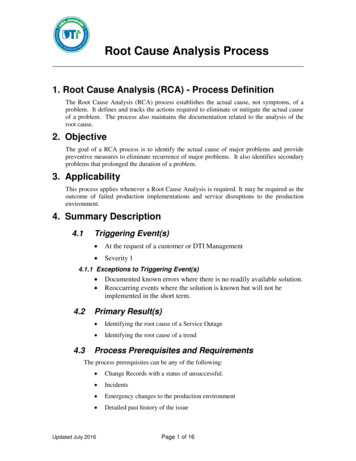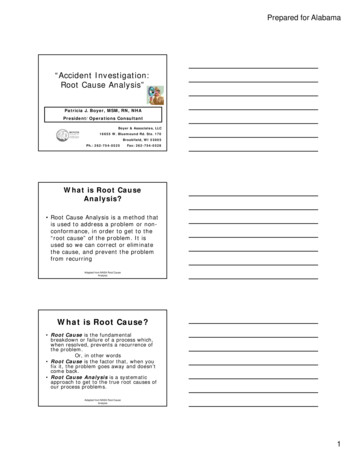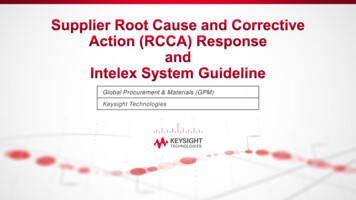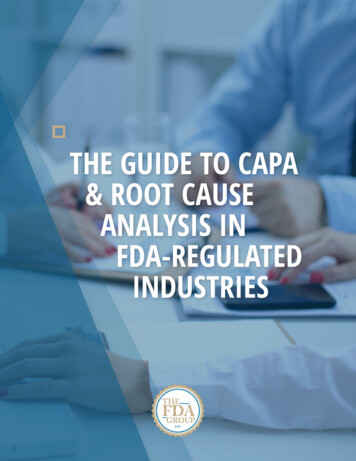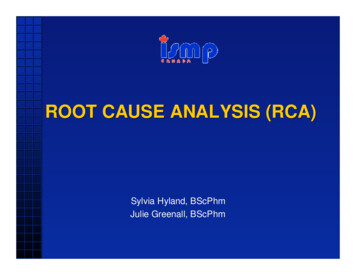
Transcription
ROOT CAUSE ANALYSIS (RCA)Sylvia Hyland, BScPhmJulie GreenallGreenall,, BScPhm
Medication Error Response“I should have read the label.”“This has not happened before.”“This is unlikely to happen again.”Physician who reported a medication error
Medication Error Response“Thank you for helping me fulfill my moral obligationto the patient’s family - my promise to the patient’swife to share the information with others so thatsteps can be taken to try to prevent the same errorfrom happening again.”Physician who reported a medication error
The definition of an error is that it isunintended.
Need to Believe:Each human error must have apreceding cause.(The discovery that a human has erred doeslittle to aid the prevention process)
It’s not the error that is the “treasure”.It’s the underlying cause that is the“treasure”.Example: Tb syringe
“Cause” implies no assignment ofblame.Refers to a relationship, or potentialrelationship between certain factors thatenable a sentinel event to occur.
The outcome of the reporting and analysisprocess must generate a “win win win win”situation for the hospital, patient andhealth care professional and otherhospitals, patients and professionals.
Root Cause AnalysisCase Example:Solu-Medrol – Depo-Medrol
Why did this child receive thewrong drug? Incorrect medication dispensed bynursing supervisor. Look-alike/sound-alike drug names. Lack of staff familiarity with Solu-Medroland Depo-Medrol due to infrequent use. Poor warning labelling on the product
Why was the incorrectmedication dispensed? Lack of drug knowledge on the part of the nursingsupervisor. Look-alike/sound-alike drug names. Products stored beside each other in Pharmacy butDepo-Medrol brand name product and Solu-Medrolgeneric product. Only size of Solu-Medrol available in hospital was 1gram vials. Poor warning labelling on product. Lack of weekend/after hours pharmacy service.
Extra safety checks completed: Dose of medication double checkedwith children’s hospital. Drug name double checked in CPS.
Additional Contributing Factors: ER department extremely busy. Supervisor had been tied up most of theday dealing with staffing issues.Supervisors have commented that theyare often filling medications “on therun”.
What are the root causes(i.e. most responsible causes)? Lack of weekend/after hours pharmacycoverage. Poor warning labelling on product.
What actions were taken as aresult of this error? Supplementary “IM use only” labels affixed to all vials &boxes of DepoDepo--MedrolMedrol. Manufacturer notified of incident and requested toconsider labelling changes. E-mail alert to all pharmacists in region. Error reported to ISMP Canada and published. Policy change was made to clearly require full disclosureof clinically significant errors to patients/families . Proposal submitted to provide weekend pharmacyservice.
Additional complicating factors (smallhospital issues): The nurse who administered the dosewas a personal friend of the child’smother. One of the hospital pharmacytechnicians was a relative of the child.
Some things that went well: Once the error was discovered, immediate stepswere taken to assess the potential for harm bycontacting the children’s hospital and the drugmanufacturer. The Chief of ER was also the family physicianand a member of the hospital medicationincident review committee. The error was disclosed to the family in a timelyway. Hospital administration was supportive ofpublishing the error through ISMP Canada.
“We must never let “good enough” begood enough. We must be relentlessin our pursuit of finding ways toimprove our systems”.VA hospital website
What is Root Cause Analysis(RCA)?Root Cause Analysis (RCA)is a technique most commonly used afteran incident has occurred in order toidentify underlying causes.Reference: Root Cause Analysis in Healthcare: Tools and Techniques, Joint Commission Resources
What is Root Cause Analysis(RCA)?A systematic process of investigating a criticalincident or an adverse outcome to determinethe multiple, underlying contributing factors.The analysis focuses on identifying the latentconditions that underlie variation inperformance and, if applicable, developingrecommendations for improvements todecrease the likelihood of a similar incident inthe future.Reference: The Canadian Patient Safety Dictionary October 2003.
What is a Root Cause?A cause may be identified as a set ofactions, circumstances or conditions.
Things to keep in mind:“Action errors follow the principle of leasteffort”.Dr. John Senders
Need to Answer the Question:What should we do to prevent this inthe future?NOTWhat should we have done toprevent this from having occurred?
Things to keep in mind:“There is an infinite number of equipotentcauses. The absence of any one maypreclude the error event”.Dr. John Senders
Picture a Tree
Proximate Causes– Superficial– Obvious (apparent)– Immediately precedeUnderlying Causes– Causes that lead to the proximate causes– Remote– Predisposing factor
“FMEA and RCA are mirror images”.
Canada:3 reports2 hosp1 ambulanceUS1 death
WorksheetProximate Causes Underlying Causes Water for inj. /water for irrig.- backorder- same product- less expensive/ one item In Central Supply: storagewith IV solutions Placed in wrong area in patient - similar packaging/labellingroom and then administeredwithout detection.- catalogue categorizedas IV- label on shelf incorrect
A Root Cause Analysis needs: To involve the “right people”– Leadership representatives, and– Individuals closely involved in process and systemunder review.– Consultants/experts (e.g. purchasing)– Interdisciplinary To continually dig deeper – ask “why” at eachlevel of cause and effect To include consideration of relevant literature To be thorough Time
A Thorough and Credible RCAShould Be: ClearAccuratePrecise Relevant Complete Systematic Possess depth Possess breadth of scope
Conducting a RCA and Developingan Action Plan Define the team (small groups and individuals forconsultation) Define the problem exactly Study the problem Determine what exactly happened Identify proximate and underlying causes Confirm the causes through consultation Explore and identify risk reductionstrategies Formulate recommendations/actions Consider Human Factors and FMEAbefore changes
Report to Senior Management Event description Scope of analysis (team members andconsultants / methods) Proximate causes Underlying (root) causes Improvement actions and follow-up plan
A product of a RCA is an‘Action Plan’Should include:– Responsibility for implementation,– Oversight,– Pilot testing if needed,– Time lines,– Effectiveness measurement.
The causative factor may bebeyond an organization’s control,however,in most cases, protection ofpatients from the effects of the‘uncontrollable factor’ can beaddressed as a risk reductionstrategy.
MSSA - Publication
Medication Safety Self-Assessment Supported by the Ontario Ministry ofHealth and Long Term Care for allOntario hospitals Added to the CCHSA guideline forStandard 14.0
Questions?
Root Cause Analysis (RCA) is a technique most commonly used after an incident has occurred in order to identify underlying causes. Reference: Root Cause Analysis in Healthcare: Tools and Techniques, Joint Commission Resources. What is Root Cause Analysis (RCA)? A systematic process of investigating a critical

